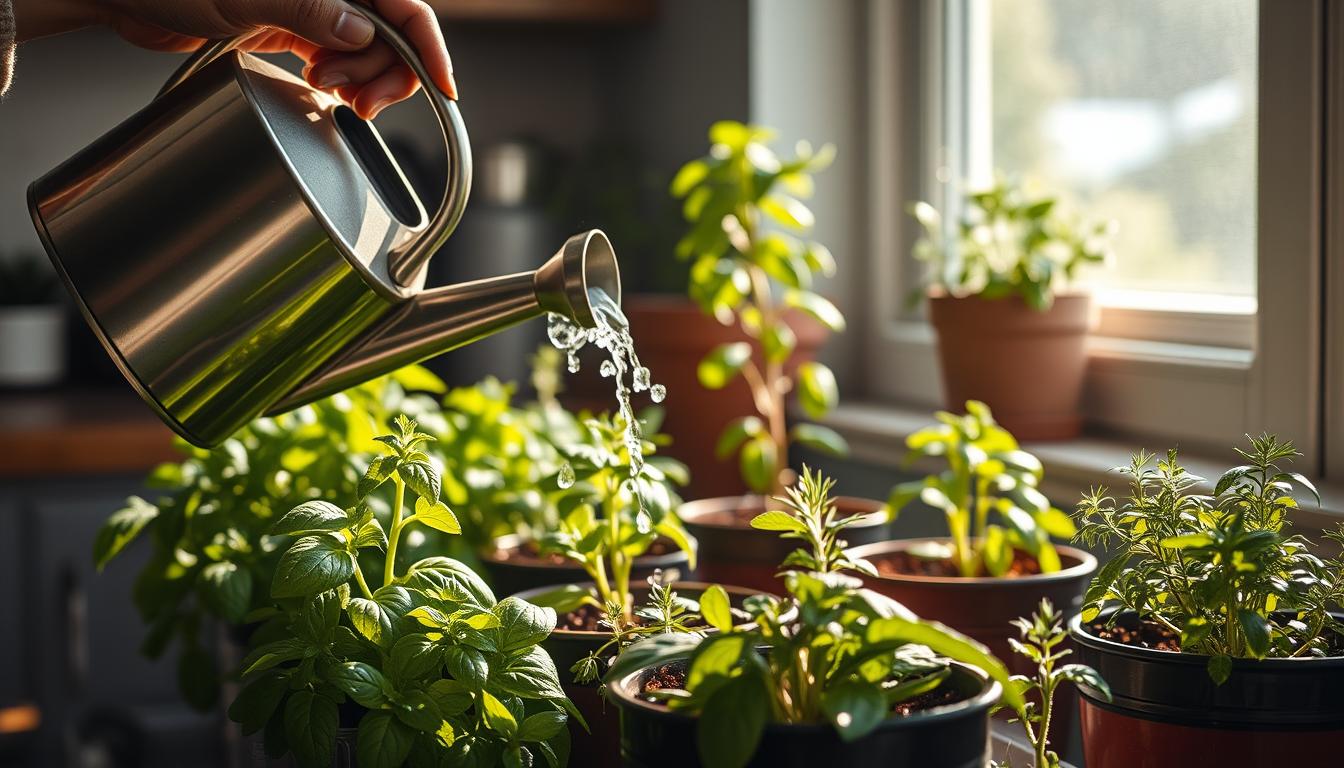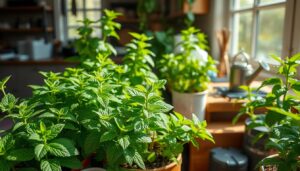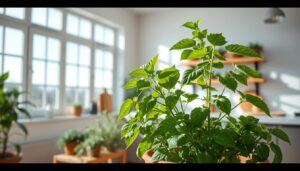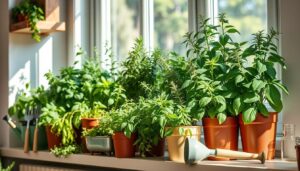Did you know that one indoor herb garden can save the average American household up to $200 per year on grocery bills? Growing your own herbs at home is a smart way to save money and add fresh flavor to your meals. It also requires careful watering to keep your plants healthy. This guide will show you how to water your indoor herbs right, making sure they grow well and improve your cooking.
Key Takeaways
- Understand the unique water requirements of different indoor herbs
- Establish a consistent watering routine for optimal plant health
- Utilize various techniques, such as misting and self-watering planters, to maintain the ideal moisture levels
- Monitor soil moisture closely to prevent both overwatering and underwatering
- Ensure proper drainage and a humid environment for thriving indoor herbs
Understanding the Water Needs of Indoor Herbs
Getting the right amount of water is key for your indoor herbs to stay healthy and grow well. Many things can change how much water your herbs need. Knowing the signs of too much or too little water is important to keep your herbs in top shape.
Factors Affecting Water Requirements
What your indoor herbs need in terms of water can change based on several factors. These include the herb type, container size, soil type, light levels, and indoor conditions. Some herbs like basil and mint need more water often, while rosemary prefers less. The size of the pot and how well the soil holds moisture also affect how often you should water.
Signs of Overwatering and Underwatering
- Overwatering: Wilting leaves, yellowing or browning leaves, and soggy soil mean your herbs have too much water. This can cause root rot and harm the plant’s health.
- Underwatering: Leaves that droop and dry, crumbly soil indicate your herbs need more water. Not enough water can stress the plants and slow their growth.
By watching your indoor herbs closely and checking the soil moisture, you can find the perfect balance. With practice and understanding their water needs, you’ll have a thriving indoor herb garden.
Establishing a Watering Routine
Creating a regular indoor herb watering schedule is key for your indoor herb garden’s success. The amount of water your herbs need varies by type, pot size, and the environment they’re in. Generally, water them when the top inch of soil feels dry. The best time to water is in the morning, letting the plants soak up the moisture before the day gets too hot.
Frequency of Watering
How often you should water your indoor herbs depends on the size of your pots, the herbs you’re growing, and your home’s humidity and temperature. Check the soil daily and water when it’s dry to the touch. This usually means watering every 2-3 days, but some herbs might need more or less water.
Best Time of Day for Watering
Mornings are the best time to water your indoor herbs. This lets the plants soak up moisture before the day’s heat makes it evaporate too quickly. It ensures they have enough water to last the day. Don’t water in the evening, as it can lead to fungal diseases.
“Establishing a consistent watering routine is the foundation of a healthy indoor herb garden. By understanding the optimal frequency and timing, you can provide your herbs with the nourishment they need to flourish.”
The indoor herb watering schedule you set should be flexible and adapt to your herbs’ needs. Keep an eye on their growth and change your watering as needed to keep your indoor herb garden healthy.
Indoor herb garden watering tips
Keeping an indoor herb garden alive is more than just watering it regularly. To keep your herbs healthy and bright, follow these indoor herb garden watering tips.
Self-watering planters are a great choice. They have a built-in reservoir that slowly feeds water to the roots. This prevents too much or too little water, making it easier to care for your herbs.
Regular misting is another good idea. A light spray of water helps keep humidity up, which many herbs love. But, don’t soak the leaves to avoid fungal problems.
Good drainage is key for the right moisture levels. Make sure your planters have holes for excess water to drain out. This stops the soil from getting too wet.
- Use self-watering planters to take the guesswork out of watering
- Mist your herbs regularly to increase humidity
- Ensure proper drainage to prevent overwatering
By paying attention to what each herb needs, you can keep your indoor herb garden healthy and full of life.
The key to a successful indoor herb garden is understanding the unique watering requirements of each plant.
Individualized Watering Needs for Popular Herbs
Growing a thriving indoor herb garden means knowing how much water each plant needs. Different herbs have different watering needs. It’s important to meet these needs to keep your herbs healthy and growing well.
Basil
Basil likes the soil to be consistently moist but not too wet. Water your basil plants often, but make sure the soil isn’t soaked. Check the soil by feeling the top inch. Water when it feels dry to the touch to keep the roots hydrated without drowning the plant.
Mint
Mint needs a lot of water because it’s a thirsty herb. It can handle more moisture than many herbs. Water it when the soil feels dry to prevent drought.
Rosemary
Rosemary is a drought-tolerant herb that does well with less water. Let the soil dry out a bit between waterings. Don’t overwater your rosemary plants. They like a drier soil.
Knowing the basil water requirements, mint water requirements, and rosemary water requirements helps you water your indoor herbs right. This ensures each plant gets the right amount of water for its needs.
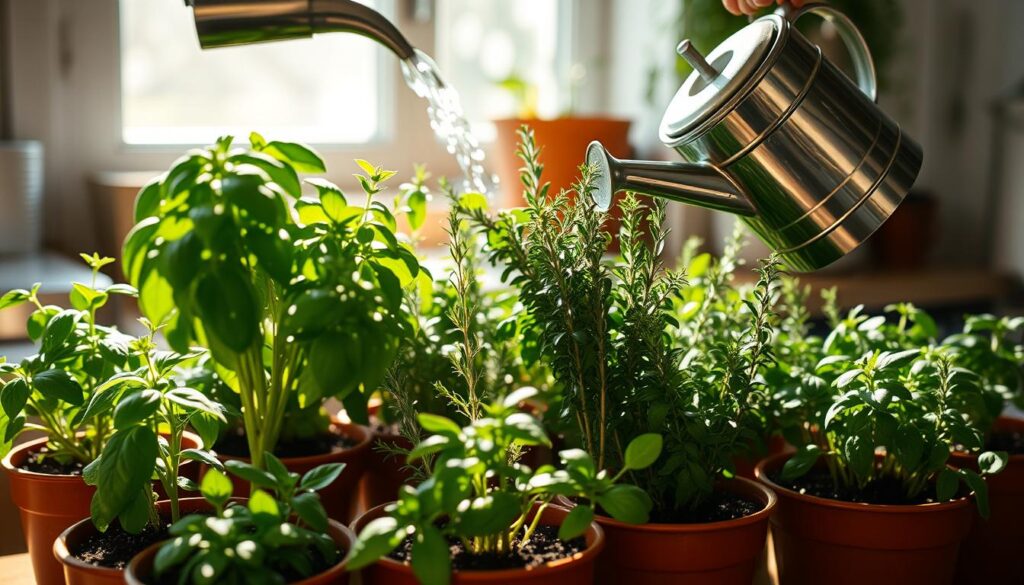
“Knowing the unique water needs of your herbs is the key to keeping them thriving in your indoor garden.”
Choosing the Right Containers and Potting Mix
When growing herbs indoors, the choice of container and potting mix is key. The right containers for indoor herb gardens and potting mix for indoor herbs keep moisture levels perfect for your plants.
Start by picking containers with good drainage holes. This stops water from pooling and causing root rot. Choose pots made of terracotta, ceramic, or plastic. These materials help with air flow and drainage.
Then, pick a top-notch, fast-draining potting mix for herbs or vegetables. These mixes keep moisture just right, letting your indoor herbs get the nutrients they need. Don’t use regular garden soil, as it can be too dense and slow down plant growth.
| Container Material | Advantages |
|---|---|
| Terracotta | Porous, allowing excess moisture to evaporate |
| Ceramic | Durable and come in a variety of styles |
| Plastic | Lightweight and budget-friendly |
Choosing the right containers for indoor herb gardens and potting mix for indoor herbs sets you up for a successful indoor herb garden. It ensures your plants get the right amount of water to thrive.
Light Requirements for Indoor Herb Gardens
Creating a thriving indoor herb garden is more than just watering. You also need the right amount of light for your herbs to grow well. If you’re growing herbs indoors or using grow lights for indoor herbs, knowing the light requirements for indoor herbs is key.
Maximizing Natural Light
Start by using natural sunlight for your herbs. Place your garden in a south-facing window to get lots of daylight. Most herbs need at least 6 hours of direct sunlight each day to do well.
Using Grow Lights
If your space doesn’t get enough natural light, don’t worry. You can use artificial lights instead. A good grow light can make sure your herbs get enough light. Choose LED or fluorescent lights that match the light plants need for photosynthesis.
Position the lights close to your plants and turn them on for 12-16 hours a day. By watering and lighting your herbs right, you’ll have a beautiful, fragrant indoor garden all year.
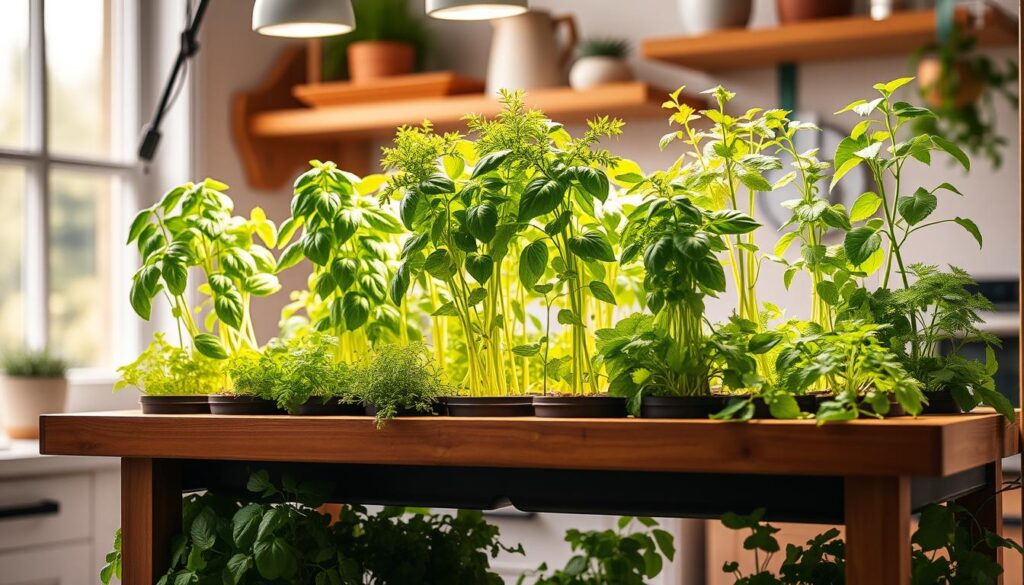
“Proper lighting, combined with a consistent watering routine, will create the ideal environment for your indoor herb garden.”
Monitoring Soil Moisture Levels
Keeping the right soil moisture is key for your indoor herbs to stay healthy. It’s important to check the soil moisture often. This way, you can make sure your herbs get just the right amount of water.
By watching for certain signs and using the right tools, you can keep an eye on your herbs’ water needs. This helps you adjust your watering schedule as needed.
Visual Cues for Watering Needs
How your herb plants look can tell you a lot about their soil moisture. Look for wilting leaves or dry, crumbly soil. These signs mean your herbs need more water.
If you see yellowing or drooping leaves, it could mean you’re watering too much. This is because of overwatering. Paying attention to these signs helps you know when to water your herbs.
Tools for Moisture Monitoring
- Soil moisture meter: This tool lets you measure the soil’s moisture precisely. It makes watering your indoor herbs easier.
- Your finger: You can also check the soil moisture by sticking your finger in it. If it feels dry and crumbly, it’s time to water.
Using both visual checks and tools helps you create a good watering schedule. This keeps your indoor herb garden healthy and full of life.
“Properly monitoring soil moisture is key to maintaining a healthy indoor herb garden. It’s the difference between your herbs flourishing and struggling.”
Preventing and Addressing Common Issues
Even with the best watering habits, indoor herbs can sometimes face problems like root rot and pests. It’s important to keep an eye on your plants and deal with issues fast. By making sure your plants drain well and watching for overwatering or disease, you can stop many problems before they start.
Root Rot and Drainage
Root rot is a big worry for indoor herbs, often from too much water or bad drainage. Make sure your pots have good drainage holes and your soil lets water flow well. If your herbs start to wilt or turn yellow, even with regular watering, they might have root rot.
Quickly change your watering ways and fix the drainage to save your plants.
Pests and Diseases
Indoor herb gardens can get pests and diseases, like aphids, spider mites, or fungi. Check your plants often for any signs of pests or color changes, and act fast if you see problems. Use safe pest control, like helpful insects or neem oil, to fix the issue. Keeping air moving and not overwatering can also stop many herb diseases.
FAQ
What are the factors that affect the water needs of indoor herbs?
How can I recognize the signs of over- and underwatering in my indoor herbs?
How often should I water my indoor herbs, and what is the best time of day to do it?
What are some tips and techniques for successfully watering your indoor herb garden?
How do the water requirements differ for various indoor herbs?
How do the type of container and potting mix affect the water needs of my indoor herbs?
What are the light requirements for a thriving indoor herb garden?
How can I monitor the soil moisture levels in my indoor herb garden?
How can I prevent and address common issues in my indoor herb garden, such as root rot and pest infestations?
Source Links
- Your Ultimate Guide to Growing Herbs Indoors – https://www.eatingwell.com/article/289996/your-ultimate-guide-to-growing-herbs-indoors/
- The Ultimate Guide To Grow Herbs Inside – https://www.stonegableblog.com/grow-herbs-indoors-the-ultimate-gudie/
- A Guide to Watering Herbs—Best Practices for a Healthy Herb Garden – https://swanhose.com/blogs/watering-herbs/a-guide-to-watering-herbs-best-practices-for-a-healthy-herb-garden?srsltid=AfmBOopfbutVHAIY9SgBZM6FLY6LHP_YzITq7kQlbSZKK2oSV5tqHa30


